10 Most Valuable Coins: Coins hold a value far beyond their face worth. The factors defining a coin’s value include rarity, historical significance, condition, and collector demand. These elements collectively contribute to a coin’s worth in the market.
The Top Factors Determining Coin Value
Rarity and Scarcity
The scarcity of a coin significantly impacts its value. Limited circulation due to various reasons, like production errors or historical events, can make a coin highly sought after.
Condition and Preservation
The condition of a coin plays a pivotal role in determining its value. Coins in pristine condition are often more valuable than those with wear and tear.
Historical Significance and Demand
Coins with ties to significant events, historical figures, or influential periods hold immense value due to their historical importance. Collector demand also propels the value of a coin.
The Ten Most Valuable Coins Worldwide: Exploring the Top 10 Valuable Coins
Coin 1: 1933 Double Eagle
The 1933 Double Eagle holds a controversial yet esteemed position as one of the rarest and most valuable coins. With a historical context tied to the Great Depression and limited in circulation due to a government order to melt down most of the coins, it carries an estimated value in the millions.
Coin 2: 1804 Silver Dollar
The 1804 Silver Dollar is another highly sought-after coin due to its rarity. With only a few specimens known to exist, it carries a substantial value among collectors, reaching into the millions.
Coin 3: 1913 Liberty Head Nickel
The 1913 Liberty Head Nickel is a coin with a fascinating history and extreme scarcity. With only five specimens known to exist, its value surpasses millions in the market.
Coin 4: 1794 Flowing Hair Dollar
This coin, among the first silver dollars minted by the United States, holds immense historical significance and rarity, making it a highly valued collectible.
Coin 5: 1870 S Seated Liberty Dollar
The 1870 S Seated Liberty Dollar is another rare coin due to its low mintage, historical importance, and exceptional demand among collectors.
Coin 6: 1794 Flowing Hair Silver/Copper Dollar
This coin, with both silver and copper content, holds a unique place in numismatic history, contributing to its considerable value.
Coin 7: 1787 Brasher Doubloon
The 1787 Brasher Doubloon, with its historical significance as one of the first gold coins minted for the United States, holds an exceptional value in the market.
Coin 8: 1933 Saint-Gaudens Double Eagle
Another variation of the Double Eagle, the 1933 Saint-Gaudens, shares a similar story of rarity and historical importance, contributing to its significant value among collectors.
Coin 9: 1822 Half Eagle
With a low mintage and a limited number of specimens available, the 1822 Half Eagle is highly valued in the world of numismatics.
Coin 10: 1652 New England Shilling
This coin, among the earliest examples of American coinage, holds immense historical significance, scarcity, and value among collectors.
Insights into Rarity and Historical Significance
Understanding Rarity and Its Impact
Rarity profoundly influences a coin’s value. Coins with limited circulation or specific historical events often fetch higher prices.
The Historical Context
Coins with ties to significant events or prominent figures hold immense value due to their historical significance.
Factors Affecting Coin Values
Factors that Elevate Coin Values
Apart from rarity, factors like condition and preservation play a pivotal role in a coin’s worth.
The Impact of Condition on Value
Coins in pristine condition command higher values, emphasizing the importance of preservation.
Historical Significance and Its Influence
Coins connected to influential periods or figures hold value due to their historical importance.
The Role of Bullion Content and Collector Interest
Bullion Content’s Influence
Coins with higher bullion content, like gold or silver, hold inherent value beyond their face worth.
Collector Interest and Market Demand
Collector interest significantly drives coin values, making certain coins more valuable due to higher demand.
Conclusion
The top ten most valuable coins in circulation are a blend of rarity, historical importance, and collector interest, reflecting the amalgamation of history and value in the world of numismatics.
FAQs
What makes a coin valuable?
A coin’s value is determined by factors such as rarity, historical significance, condition, and demand among collectors.
Are these valuable coins easily accessible?
Most of these valuable coins are rare and not easily accessible. They’re often part of private collections or museums, making them scarce in the market.
Do all valuable coins have historical significance?
Yes, a significant number of valuable coins have historical ties, be it through events, figures, or their minting circumstances, which adds to their value.
Can coin condition significantly affect its value?
Absolutely. The condition of a coin plays a crucial role in determining its value. Coins in better condition generally command higher prices.
How can one determine the value of a coin?
Determining a coin’s value involves assessing factors like rarity, condition, historical significance, and current market demand. Professional appraisers or numismatic guides can aid in determining a coin’s value.





